PIEZO-DRIVEN MICRODISPENSERS
The need for miniaturization and precise placement of the low volume droplets on different substrates (microelectronics, CMOS, cantilevers, MTPs, etc.) grew heavily over last few decades. Low volume liquid applications are used across different areas, from in vitro diagnostics till microelectronics; in general, everywhere where high dispensing accuracy and ultra-low volume droplets or lines are needed. The best choice for precise dispensing of controlled and stipulated liquid amount is a non-contact dispenser with a piezo-electric displacement, which enables repeatable and very accurate deposition of droplets. Repeatable and accurate means that the droplets have to be placed on the surface many times, with the same volume, same size, and the same concentration. Likewise, the piezo-dispenser allows better positioning and easier height adjusting functionality, because of no Z-axis movement. All these factors are the prerequisites of high precision dispensing and have to be considered, when choosing a dispensing technique, as they have a big impact on the quality of the final product.
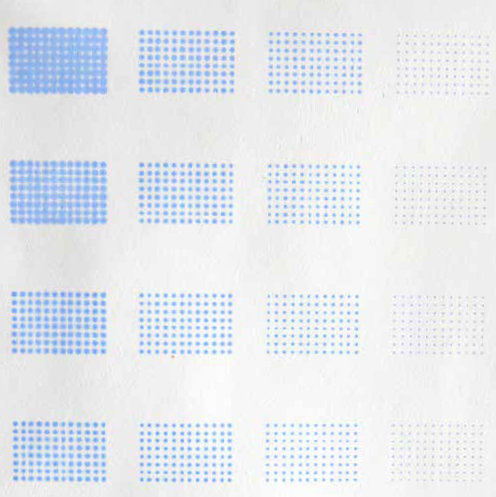
The former dispensers are based on piezo-electric valves which quickly open and close themselves. The process of opening and closing causes an ejection of the liquid on a target substrate. The valve is extremely accurate and consistent but getting to desired dispensing volume demands certain tuning. Critical anomalies in dispensing performance, like a small change of internal geometry of the valve which can be visible after removing the sample, after cleaning process, or during maintenance. The very rapid process of repeated opening and closing of the valve leads to heating of the valve, and eventually affecting the quality of the aspirated liquid, spot size or quality of the spotting, and spot position on the target surface. This was one of the limiting issues of the older piezo-electric dispensers.
The latest piezo-electric technology is based on a ceramic piezo actuator, which is placed around the glass capillary. The purpose of using an actuator is to convert electric energy into mechanical. The electric pulse leads to a contraction of the ceramics, generating a wave in the capillary and ultimately leading to ejection of a droplet. The piezo actuators by themselves are reliable, maintenance free and extremely accurate in repeated dispensing of identical volumes.
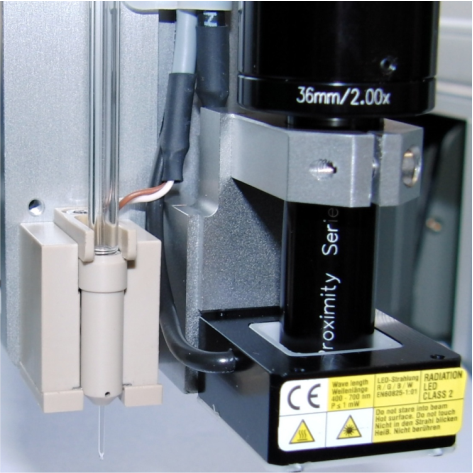
These piezo-dispensers are produced also by M2-Automation, where the capillary is made of borosilicate glass. Dispensers are dedicated for dispensing very low volumes, from 30 picolitres (pL) till low microlitres (µL), with frequency of 1-1000 droplets per second. Droplets are generated by instant pressure gradient that doesn’t cause any damage to the tip or surface, because there is no contact. Every piezo-driven microdispenser (PDMD) offers a range of volumes that is at least twice as large as the smallest volume. The orifice diameter is critical for obtaining suitable droplet formation, the PDMD orifice's size and the diameter of the droplets are of the same order scale.
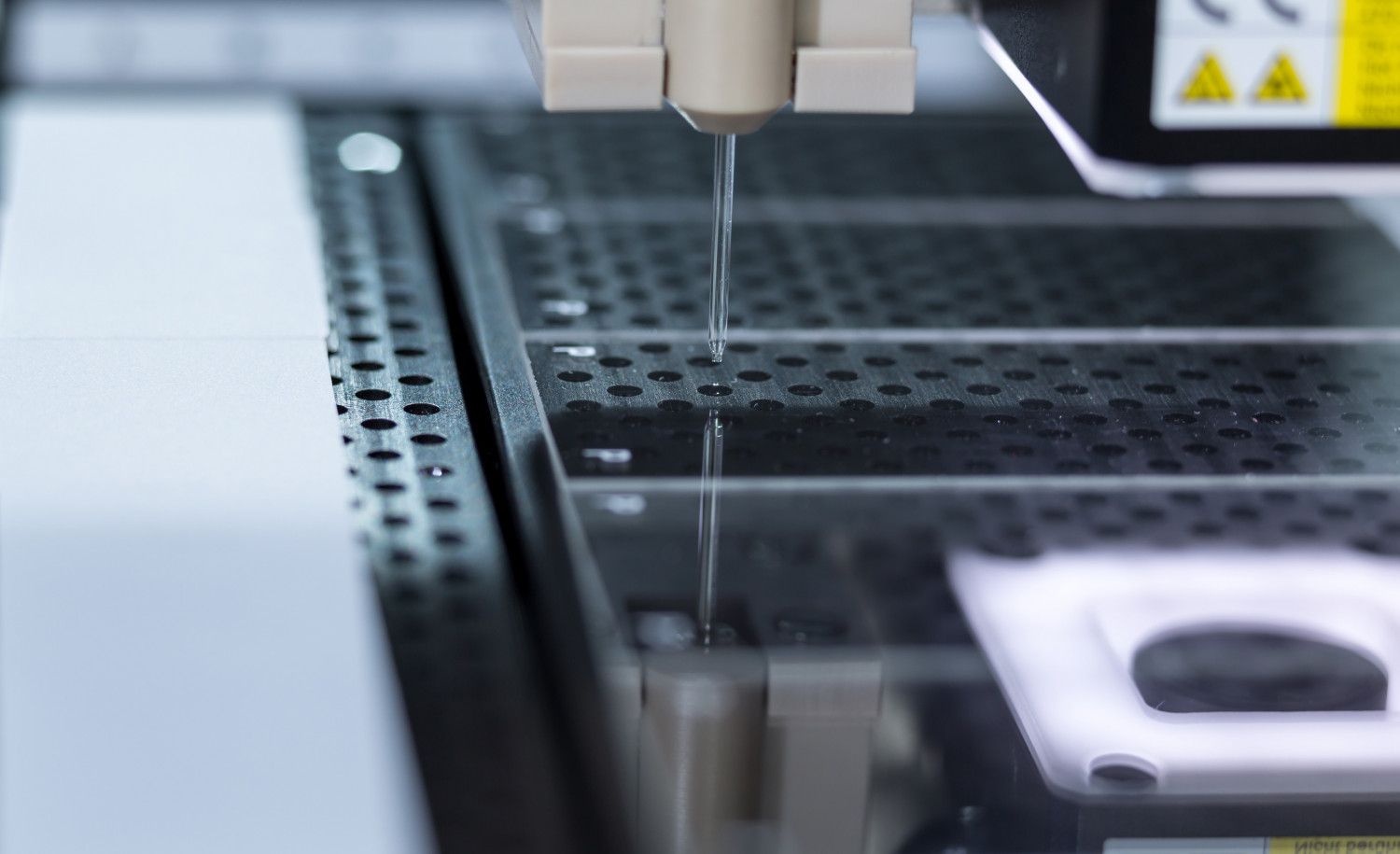 PDMD on a glass slide
PDMD on a glass slide Nowadays, there are several different types of piezo-dispensers (PDMDs) available within M2-Automation. These PDMDs differ in the amount of dispensed volume and size of the orifice. The most special one is the ultra-low volume dispenser, which can dispense volumes starting from approximately 30 picolitre, depending on the sample solute on. The capillary of the ultra-low volume PDMD dispenser being very small and requests special handling – has to be washed with pressure of maximum 1µl/s, sample is not allowed to contain any free particles, viscous samples and cells are neither suitable, due to the narrow capillary, leading to clogging or a damage. At applications, where particles, highly viscous samples or cells are used, it is better to choose dispensers with a bigger orifice, where clogging is hardly experienced, and cells are not getting damaged while spotting. The PDMDs seldom need a coating kit, but for the samples that are really difficult for spotting, for instance membrane proteins, peptides in DSMO or high hydrophilic samples, special coating kits are available to cater these problems.
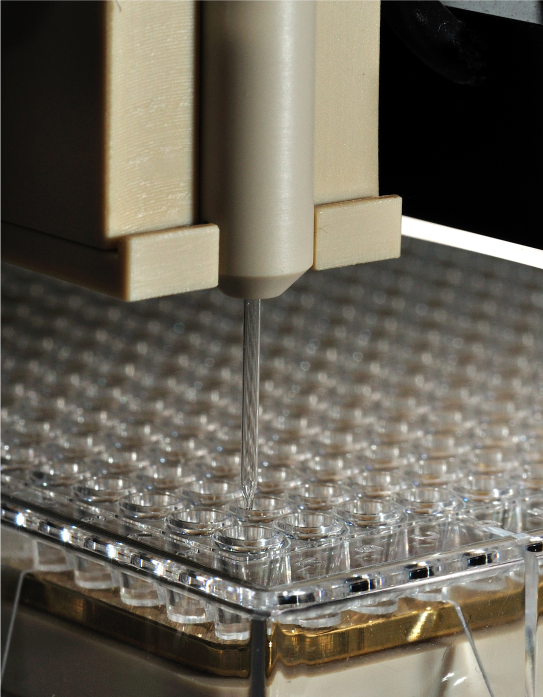
The fastest dispensing can be achieved with the standard volume dispenser (PDMD), which is also suitable for spot on the fly (SOTF) dispensing, with 3200 droplets per second and with a magnetic drive speed of 1.0 meter per second.
Spot On The Fly (SOTF) mode
In cases where continuous dispensing without aspirating the sample while spotting is prerequisite, PDMD bulk dispensers are available. The dispensing volume is usually 0,5 ml but can be adapted to higher amounts on request.
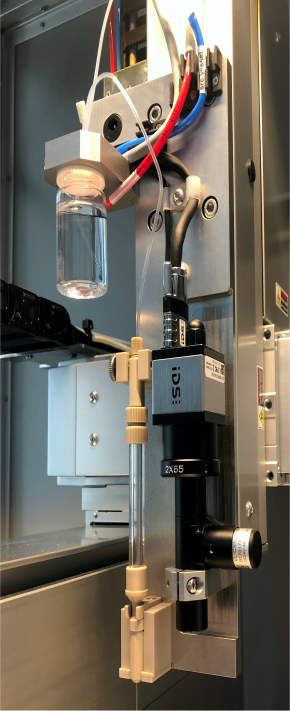
As dispensing is not a simple method and almost every application is unique, customizing every spotting becomes a mandate. Liquid droplets, depending on the surface to be spotted behave differently, ranging from complete spreading to minimum wetting (according to the sample type, contact angle, temperature, and humidity. Controlling mobility of the droplets, microarray is particularly a crucial aspect governing spot precision which is an important insistence for microarray. To achieve proper droplet formation, consideration must be given to the placement, diameter, configuration of the orifices or using a coated target surface. Sometimes it is sufficient to use the auto tuning software for spotting optimisation.
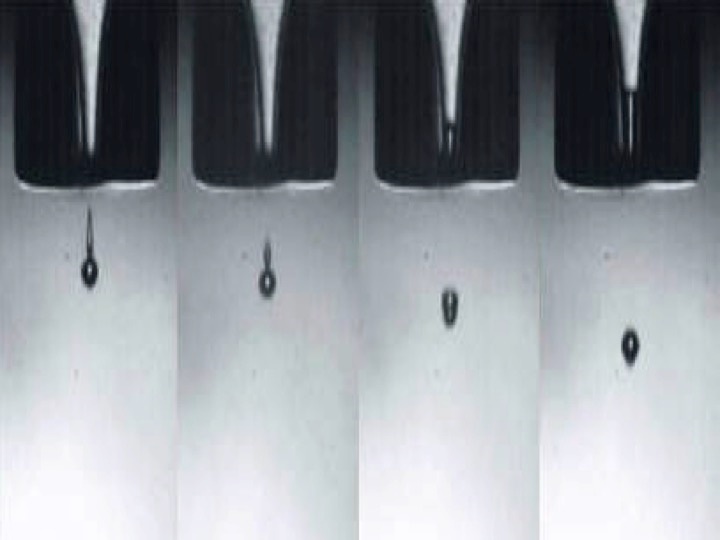
Inconsistencies like increase in air pressure or capillary clogging especially when the capillary bore is extremely small, liquid movement through the dispenser may create satellite droplets. On the other hand, change of these parameters may result in adhesion or a reduction in the size of the droplets. Hence, it is important to select a dispenser with a proper size for the given application.
Apparently if the calculated volumes differ from the actual ones or the concentration of the liquid changes during the spotting process, it is important to monitor the ejection process and adjust parameters as appropriate. The aspiration speed and mixing zone height both have an impact on concentration, while taking too small sample volumes and influence the diffusion zone in between sample and the system liquid. Additionally, diffusion also affects the gradient of concentration. The concentration gradient can be reduced when printing buffer is aspirated before aspiration of the sample.
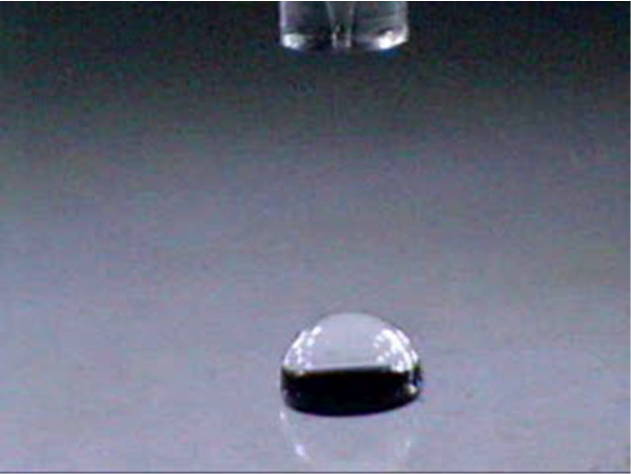
Perfect droplet
The viscosity of the liquid significantly rises with solute concentration, including evaporation of liquids containing protein molecules and the evaporation of printed droplets. Assembling biomolecules or particles on the margin of a drying droplet leads to coffee stain effect. To avoid this issue, it is crucial to apply printing settings that produce an even distribution of active biomolecules for example by using humidity-temperature control system which allows DEW point control for a stable presence of sample droplet on the desired target and enables the sample source plate to be free of evaporation during the printing processes.
